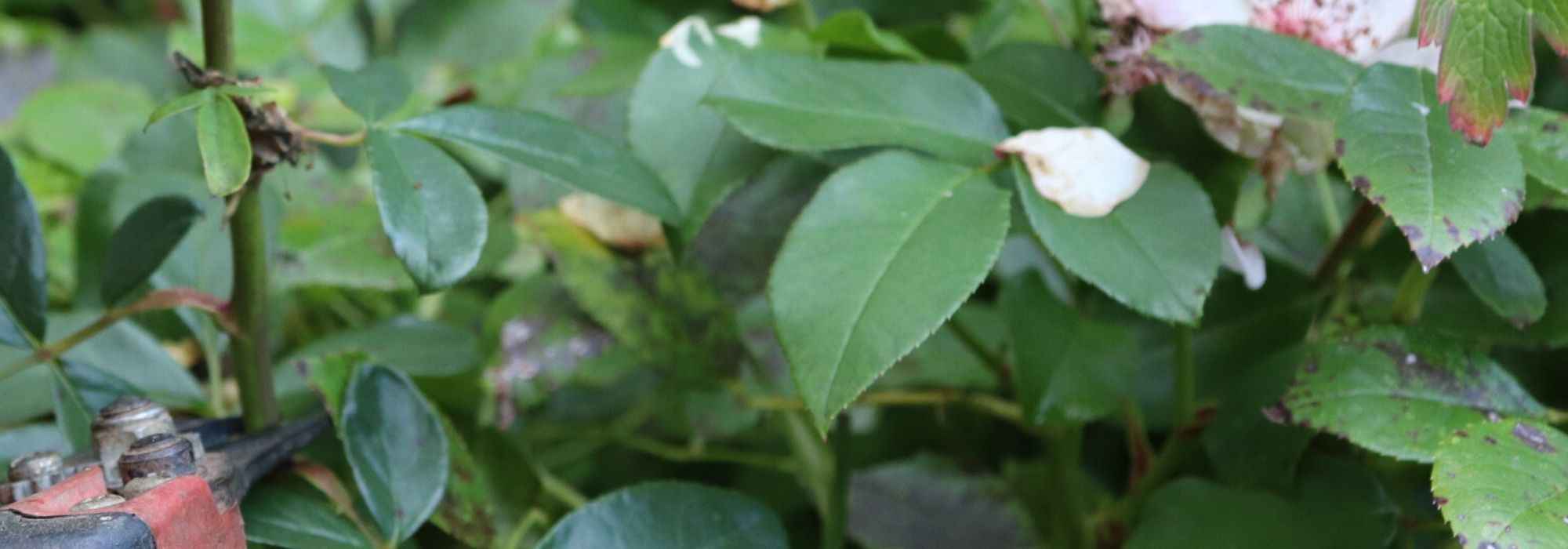
Pruning roses
Techniques and tips
Contents
Pruning roses is such a common garden task that it’s sometimes done without gardeners even knowing why!
In nature, roses send out long vigorous stems that become ramified over time, then become exhausted as new shoots appear. These shoots take up the sap. The oldest branches dry out. The whole plant becomes very messy and produces small scattered flowers.
Pruning roses aims to discipline the plants by directing sap towards selected young shoots. This results in larger, more numerous flowers.
Discover our tips on when and how to prune roses!
When to prune roses?
Pruning of roses can be carried out at different key times of year depending on rose type or whether they are perpetual or not.
- either prune after flowering (July or even August) for non-perpetual roses (which flower only once) except if you want to enjoy ornamental hips
- or what is known as autumn pruning or Christmas pruning. In that case, prune in November for autumn pruning and between Christmas and the end of January for Christmas pruning ;
- or prune at the end of winter (February/March or even April in very cold climate) perpetual roses, whether climbing, bush or shrub.
→ For more information on ideal time to prune roses, see our advice sheet: “When to prune roses?”
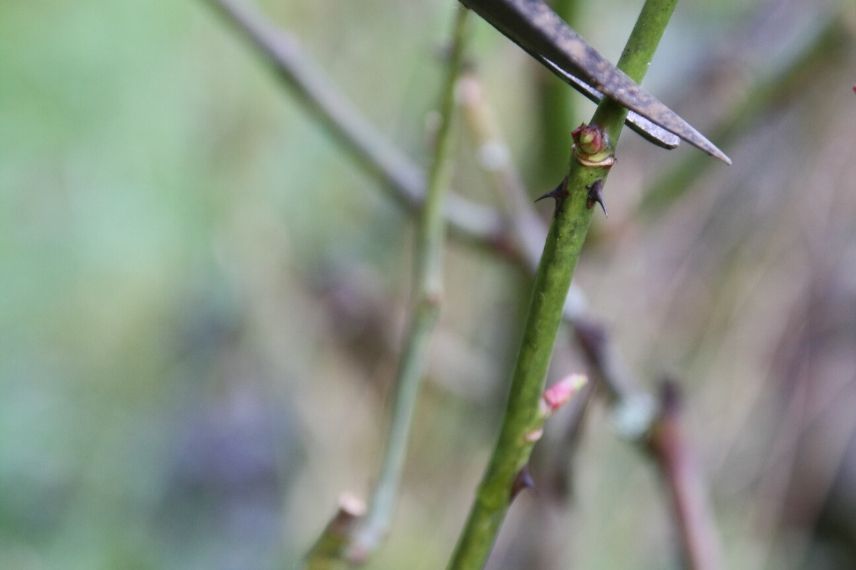
Read also
What is a perpetual rose?How to prune roses?
It is easy to feel lost faced with volume of information on pruning roses, often contradictory. In reality, there is not a single way to prune but several, varying with type and form of rose. However, you can follow a few simple general principles.
Equipment
First thing is to equip yourself with good tools! Ideally, you will need:
- pruning shear of good quality and well sharpened;
- loppers or a small saw to cut old main wood;
- a pair of gloves (there are special rose gloves or, failing that, choose ones not too thin and, if possible, covering forearms) to protect you from thorns;
- Not forgetting a bottle of methylated spirit and a cloth to disinfect tool blades between each rose to avoid transmitting any diseases.
Prune in right place
Too long a cut leaves stem stubs that dry out. Necrosis then forms and can spread along the stem. Don’t worry, nothing serious — you can correct this by cutting back that stub as soon as you spot it. Conversely, too short a cut creates a wound that, when healing, will starve the young shoot emerging. That shoot will probably disappear.
Correct cut is clean and sharp, beveled so water does not stand on the cut (which favours diseases), and angled about 45° away from the eye so water does not run onto it. Always cut 5 mm above a well-visible bud, preferably facing outwards from the rose bush.
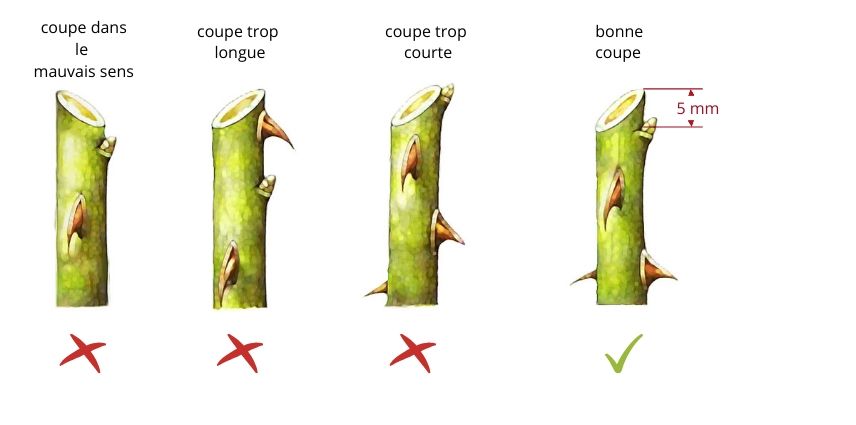
Diagram showing correct cut and errors to avoid
Now that two important details are clear, let’s get to the heart of the matter.
How to prune perpetual roses?
Perpetual roses form flowers at tip of shoots that develop during the year. Main pruning is done in late winter to remove old wood and stimulate production of young flowering shoots. It is also possible to do autumn pruning or Christmas pruning, not essential but useful to lighten work in late winter. Finally, you can prune from second year after planting. To do this:
- whatever pruning time, always start by removing dead branches (brown in colour) as low as possible, those broken or damaged by rubbing and weather. Scars are open door to pathogenous germs and to formation of cankers. Centre of rose bush must be cleared; air must circulate!
- also remove very weak shoots that will not produce flowers;
- then shorten main stems by a third or even by half for bush or shrub roses (see below: at what height to prune roses?). By contrast, leave main frameworks undisturbed for climbing roses and shorten secondary branches leaving only 3–4 eyes. Remember to train main branches as horizontally as possible to encourage shoot development along their whole length.
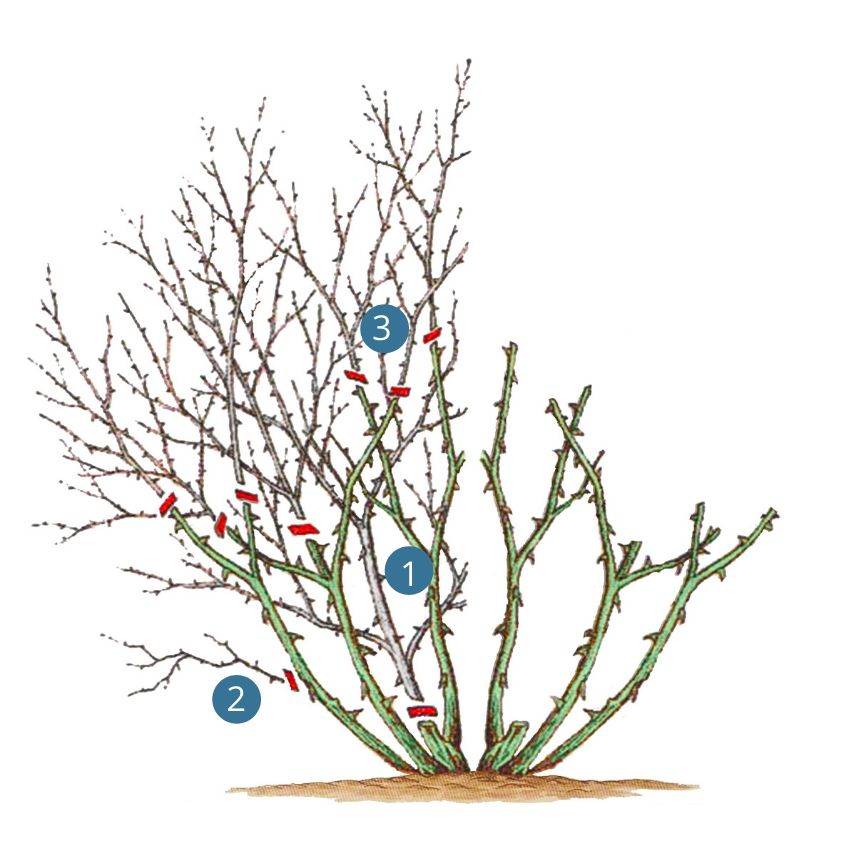
Diagram showing before/after of main pruning of a perpetual rose in late winter
How to prune non-perpetual roses?
Non-perpetual roses bear flowers on branches aged two years. They are therefore pruned only after flowering, in July or August, unless you want to keep hips. To do this:
- remove oldest branches, dead wood as low as possible or remove one or two old branches each year to encourage new shoots;
- cut back each branch by one third;
- balance silhouette of rose bush.
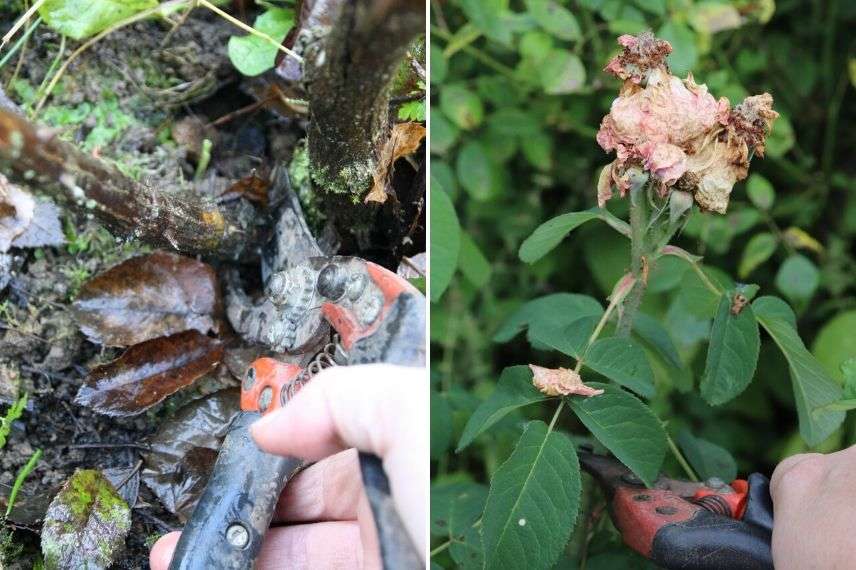
Pruning of non-perpetual roses: removal of dead wood and cutting back one third of branches
Some additional tips:
- prune preferably in dry weather to avoid fungal diseases;
- do not prune during freezing period; healing will be better;
- if in doubt, better to prune less than prune too much.
Discover other Roses
View all →Available in 0 sizes
Available in 2 sizes
Available in 1 sizes
Available in 2 sizes
Available in 2 sizes
Available in 2 sizes
Available in 3 sizes
Available in 2 sizes
Gardeners' questions
At what height should rose bushes be pruned? Should you cut short or leave long?
Gardeners often ask about cutting length.
The answer is quite simple. Cutting length depends on the final size desired for the rose bush. Some rose bushes become large and have the unfortunate habit of producing flowers at the tips of the stems, which are therefore out of sight and/or of branches completely bare at the base, which is unsightly. It is better to prune them shorter so flowers are at eye level and to encourage the rose bush to produce low branches.
Also bear in mind that pruning affects the rose bush’s growth: the more severe the cut, the stronger the bush’s reaction. In other words, it is better to prune weak rose bushes short and to prune vigorous ones more lightly. Note also that severe pruning of a strong bush will limit the number of flowers. However, the flowers will be larger. This is therefore a good idea for roses intended for cut flowers but not justified when seeking a striking mass display.
Finally, foliage is essential for absorbing nutrients and for the rose bush’s development. Frequent severe cutting can weaken plants. In that case, prune a weak specimen short until it has filled out well. It is therefore up to you to adjust your action according to the type of rose bush and your objective.
How to remove faded flowers from roses?
At the end of flowering, remove one-third of the branches that have flowered. To do this, cut on the slant just above a bud facing outwards. This bud will develop and produce another floriferous branch.
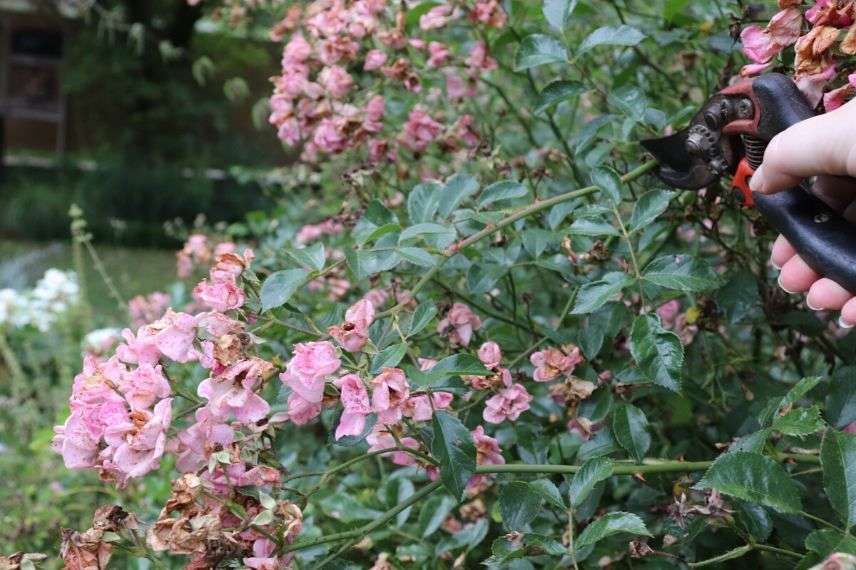
Pruning faded flowers
How to prune an old rose bush?
After a few years without maintenance, old wood accumulates and rose bushes become unproductive; branches cross over one another in the heart of the bushes and they may even suffer from an attack by pathogenous fungi. Moreover, these old branches monopolise all the sap to the detriment of forming new floriferous shoots.
It is time to rejuvenate your rose bush by cutting these old branches as low as possible. Use loppers or a small saw. For large wounds, you can apply a wound sealant (ensure the wound is clean before application so as not to trap germs). The rose bush should produce new shoots.
- Subscribe!
- Contents
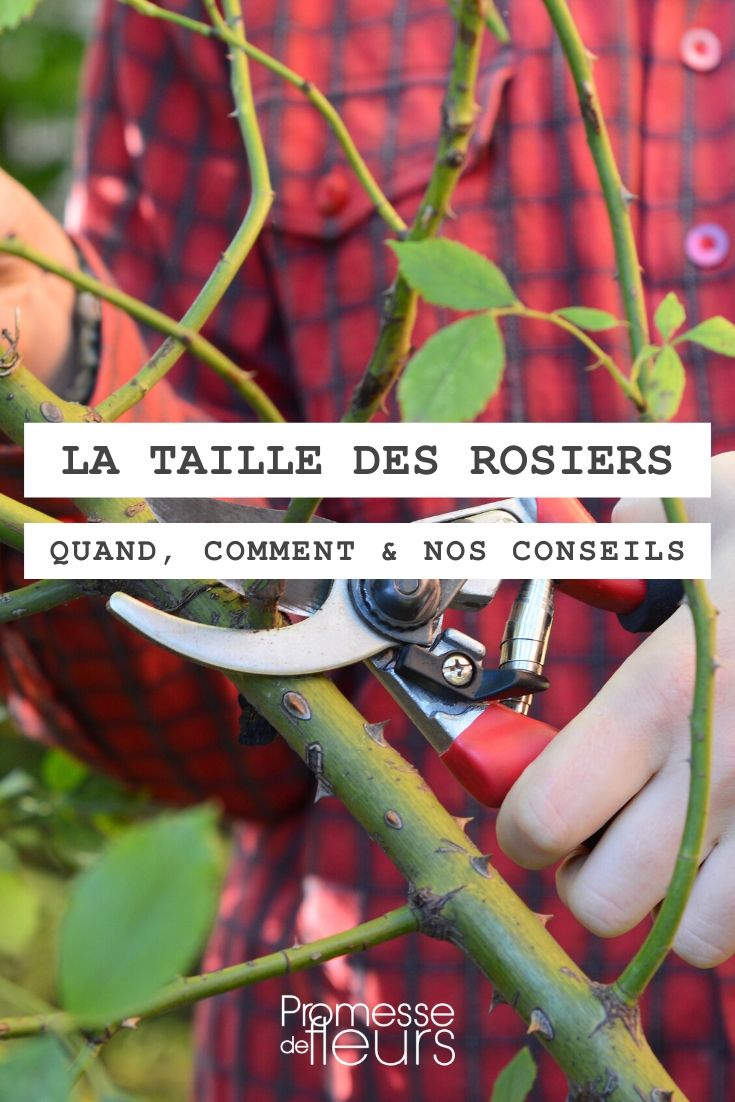
































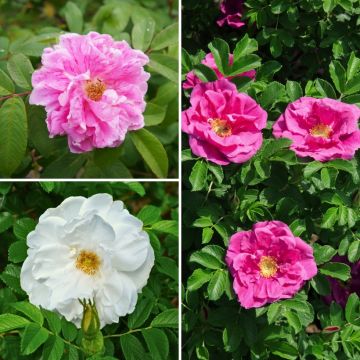





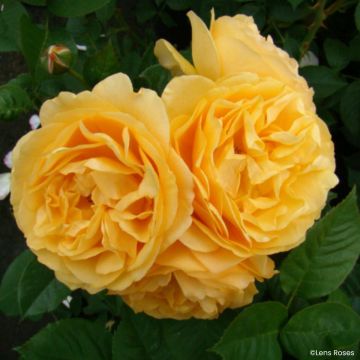
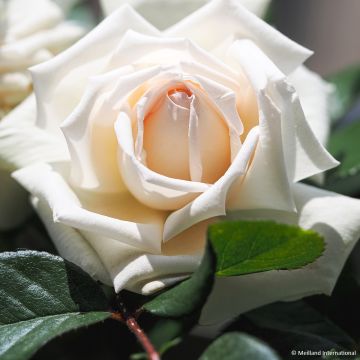
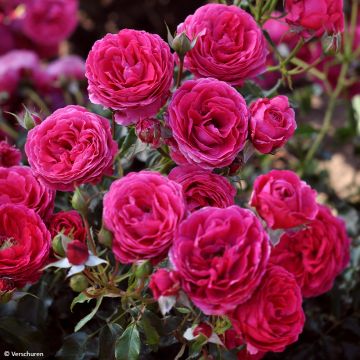
Comments